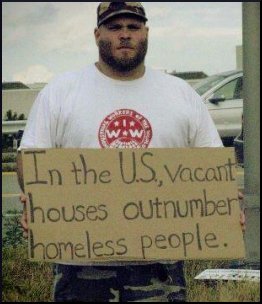
In April, the Associated Press reported that Operation Stand Down Rhode Island opened six service-enriched homes for veterans. In May, Fran Daniel reported on the plans in Winston-Salem, North Carolina, to rehabilitate a set of apartments, mostly for military veterans. In Forsyth County, there was already a 24-bed transitional housing program that allowed up to two years residency for homeless vets working to get back on their feet.
The apartment remodeling project represented a branching-out on the part of Whole Man Ministries, which maintained a church, a food bank, a clothing bank, a computer lab, an after-school program for kids, and a mentoring programs for prisoners, but had never before attempted to house the homeless. The organization bought two duplexes that had been scheduled for demolition and began fixing them up to create four apartments, one equipped for handicap access.
Help was solicited from local carpenters, plumbers, and businesses. The city’s director of community and business development, Ritchie Brooks, voiced to the press concerns felt by many local residents:
Generally if you can get volunteers and have some good supervision or a good contractor, you can make it through the rehab pretty successfully. But after that rehab, it’s the management portion that would still be of a concern — being able to adequately do that so that it’s not going to be a burden or have some negative impact on the community.
In June, Habitat for Humanity began an initiative called Veterans Build and took over the National Mall in the nation’s capital to build seven house frames which would later be moved to local sites and finished. The same week, C. Andrew McCawley, CEO of Boston’s New England Center for Homeless Veterans, wrote for publication about his own state, which contained an estimated 1,200 homeless vets at any give time, and the national scene:
The country is now more than halfway into a dedicated five-year campaign to end veterans’ homelessness, and a 20 percent reduction has been achieved nationwide, with select states, such as Massachusetts, demonstrating even greater progress. The state’s plan is a comprehensive strategy and course of action with the explicit goal of ending veterans’ homelessness in Massachusetts by the end of 2015.
Massachusetts has broken its goal down into four main areas:
Implement a housing strategy to re-house and stabilize veterans who become homeless
Ensure veterans who are most at risk of homelessness remain housed to prevent homelessness
Increase access to benefits and resources for veterans through greater intervention
Align and integrate federal, state, and community resources to support veterans through effective partnerships.
In the same month, news came from Florida that the Lee County Homeless Coalition got together with other agencies to do something about chronically homeless veterans, in other words, the individuals who had been on the streets for the longest time, chalking up bills in emergency rooms because of their medical conditions including addiction. First, the needlessly complicated local housing voucher system was streamlined. But here is the important part:
Coalition members are referring all veteran clients to Veteran Affairs outreach. Permanent housing options are being identified using a Housing First approach centered on providing people experiencing homelessness with housing as quickly as possible, then providing services as needed.
Housing First a winning idea
In city after city, the idea is slowly catching on that plenty of taxpayer money can be saved by identifying the most needy and service-intensive people and getting them help. With “housing first,” expenses are markedly reduced, and there is more money left over to distribute among other housing efforts.
Perhaps the most egregious example was seen in Fresno, California, where a man died in January who had called for an ambulance on a daily or sometimes twice-daily basis for almost a year, accruing hundreds of thousands of dollars worth of charges. If he had been placed in services-enriched housing, the taxpayers and the hospital would both be in better financial shape.
The “housing first” principle was illustrated to the citizens of Saskatoon, in Canada’s Saskatchewan Province, where a study concentrating on 23 chronically homeless individuals showed that their care was costing $2.8 million per year, divided between emergency room visits, psychiatric hospital visits, ambulance trips, overnight detox visits, and jail stays. Knowledge that $2 million could be saved by providing services-enriched housing for just this small number inspired United Way to turn its efforts in the “housing first” direction.
(To be continued…)
Reactions?
Source: “Local nonprofit organization to rehab apartments for homeless veterans,” Winston-Salem Journal, 05/12/13
Source: “Habitat for Humanity building homes for homeless vets on National Mall,” MyFoxDC.com, 06/02/13
Source: “Ending homelessness for veterans,” Boston.com, 06/03/13
Source: “Help for homeless veterans : 50 homes in 100 days,” WinkNews.com, 06/12/13
Source: “Housing 23 homeless saves taxpayers $2M,” TheStarPhoenix.com, 06/14/13
Image by unknown.


